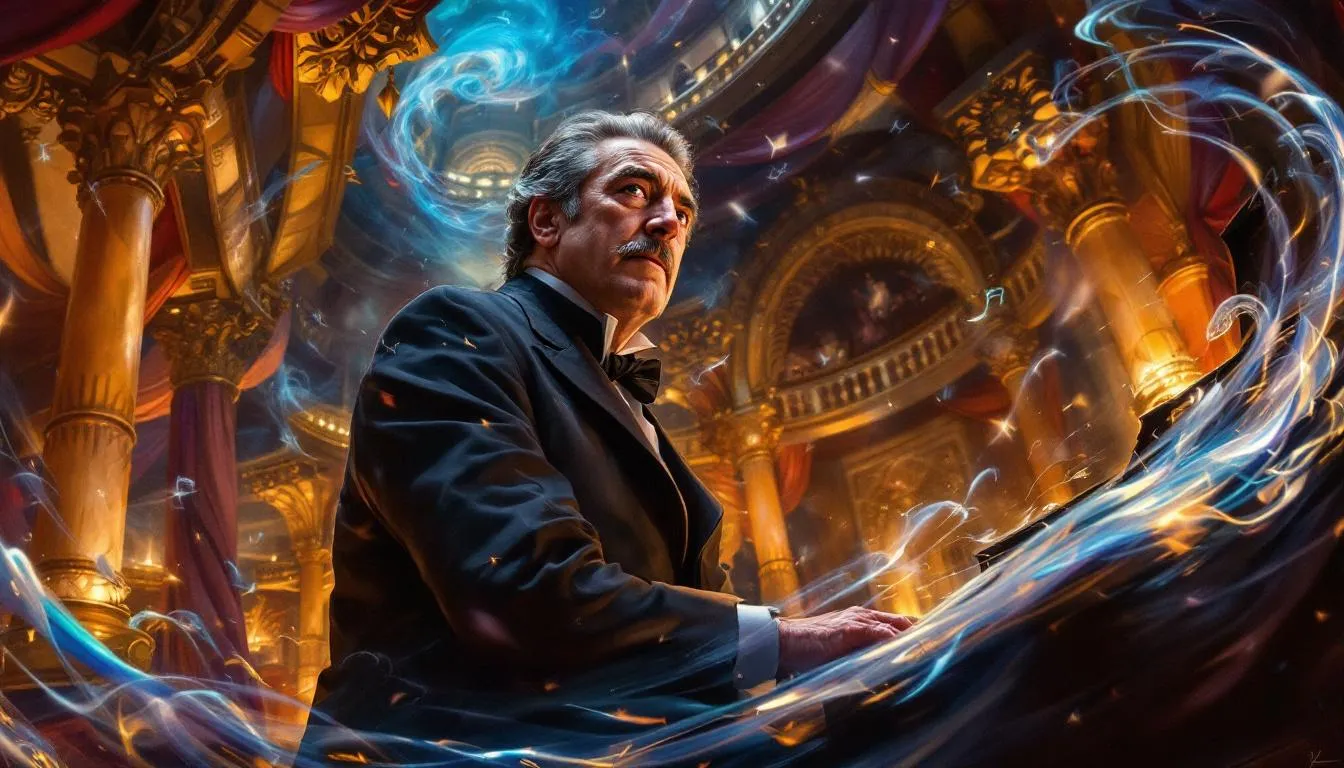Quick Answer
Giacomo Puccini’s music is celebrated for its lush, emotive harmonies and innovative use of chromaticism, akin to a painter wielding bold, unexpected colors to evoke deep emotions. His intricate harmonic language added layers of complexity and emotion, leaving a lasting influence on both opera and film scores. Puccini’s harmonic genius warrants broader recognition for its profound impact on modern music, particularly among Hollywood composers.
To truly appreciate Puccini’s brilliance, we must explore the intricacies of his harmonic language and understand how it redefined musical storytelling.
What Is Puccini’s Harmonic Language?
Exploring Puccini’s harmonic language reveals a vibrant world where notes and chords interact with emotional depth, akin to living inside an epic movie scene. Puccini was a master of chromaticism, skillfully using notes outside the traditional key to introduce unexpected twists and turns, making his music both thrilling and heart-wrenching.
Picture a movie where the villain appears, and the music shifts to a darker, more intense harmony. This chromaticism creates tension and emotion, a technique Puccini mastered in opera long before it became a film score staple. He used these harmonic colors to give each character and moment a unique emotional fingerprint.
One of my favorite moments in “La Bohème” is when the orchestra swells with lush chords, enveloping the audience in the warmth of a blossoming romance. It’s not just about the notes but how they guide you through the story, like a musical tour guide whispering secrets about the characters’ hearts.
Puccini’s harmonic language transcended clever notes, crafting vivid emotional landscapes that resonate long after the curtain falls. Understanding these intricate harmonic relationships can be greatly aided by modern tools. For example, a music theory app like Piano Companion offers a flexible piano chord and scale dictionary, which can help musicians explore and identify complex chords and scales, similar to those Puccini masterfully employed. As we further explore, it’s fascinating to see how these techniques have influenced generations of composers, especially in film.
How Did Puccini Influence Hollywood Composers?
Walking into a darkened theater and hearing music that makes your heart race or melt often echoes Puccini’s genius. His use of chromaticism and emotive harmonic shifts left an indelible mark on film scores, offering Hollywood composers a toolkit of musical colors to paint their stories with the depth he pioneered in opera.
In my teaching days, I loved comparing a classic film scene with a Puccini opera moment to illustrate their similar emotional impact. For instance, the tension-filled harmonies in John Williams’ Star Wars soundtracks often mirror Puccini’s unexpected harmonic shifts that heighten drama and emotion. It’s no stretch to say Williams, along with greats like Ennio Morricone and Hans Zimmer, borrowed from Puccini’s playbook.
Morricone’s work in The Mission and Zimmer’s compositions for Inception both echo Puccini’s style, using complex harmonies to evoke deep emotions. Even in more subtle scores, Puccini’s influence colors scenes with nuanced emotional undertones.
These composers have woven Puccini’s harmonic innovations into the fabric of cinematic storytelling, proving his influence remains as relevant today as it was over a century ago. This exploration highlights how his techniques shine in some of his most celebrated works.
What Makes “Madame Butterfly” a Harmonic Masterpiece?
“Madame Butterfly” is a vivid tapestry of musical storytelling where Puccini’s harmonic genius shines through. This opera is a harmonic masterpiece, weaving a rich emotional narrative through innovative harmony.
A standout feature of “Madame Butterfly” is its seamless blend of Western musical traditions with Eastern influences, reflecting the cultural conflict central to the story. Puccini masterfully employs pentatonic scales and modal harmonies to evoke the setting of Japan, crafting a soundscape that is both exotic and deeply moving.
The “Humming Chorus” is a striking scene where Puccini uses lush, layered harmonies to convey anticipation and longing. The harmony resembles a gentle wave, washing over you with peace and sadness. I remember playing this piece for my students and watching them close their eyes, captivated by its beauty.
Another unforgettable moment is Butterfly’s aria, “Un bel dì vedremo,” where Puccini’s chromaticism and harmonic shifts mirror Butterfly’s hope and heartbreak. The music swells and contracts, much like the waves she watches, waiting for her love’s return—an emotional storytelling masterclass.
Puccini’s harmonic choices elevate the narrative, painting emotions with sound in a timeless and profoundly affecting manner. These elements not only define “Madame Butterfly” but also set Puccini apart from contemporaries, showcasing his unparalleled musical vision.
How Does Puccini’s Harmonic Style Set Him Apart?
While many of Puccini’s contemporaries like Verdi and Wagner rooted themselves in distinct traditions, Puccini carved a niche uniquely his own. He was the musical equivalent of a master chef, blending ingredients from different cuisines to create something both familiar and new. The table below highlights some key distinctions:
His harmonies often dance on the edges of traditional tonality, weaving around it in a way that feels both daring and deeply satisfying. Imagine a melody that takes a surprising turn, leading to unexpected beauty. This was Puccini’s gift—harmonic unpredictability that kept audiences captivated.
Puccini’s influence extends beyond opera houses, trickling into modern music, from Hollywood’s sweeping scores to contemporary classical compositions. The emotional intensity he achieved through harmonic innovation is evident in the works of subsequent composers, many striving to replicate Puccini’s ability to stir deep emotions.
Exploring Puccini’s lasting impact reveals a harmonic genius that not only set him apart in his time but continues to resonate, inspiring new generations to delve into the depths of musical storytelling.
Key Takeaways
- Puccini’s chromaticism added emotional depth and complexity, influencing music beyond opera.
- His harmonic language paved the way for modern film scores, impacting composers like John Williams and Hans Zimmer.
- “Madame Butterfly” exemplifies his innovative blending of Western and Eastern musical elements.
- Recognizing Puccini’s contributions enriches our understanding of music history and its evolution.
- Explore Puccini’s works to appreciate the emotional storytelling power of harmony in music.
Embrace Puccini’s genius to inspire and deepen your own musical journey!
